無機化合物は、水質に重要な役割を果たしています。その存在または不在は、水生生物、人間の健康、および産業プロセスに大きな影響を与える可能性があります。UV/Vis分光光度法は、さまざまな無機物質の濃度を確実に測定できます。
硝酸塩
硝酸塩は、水域に一般的に見られる窒素ベースの化合物です。少量の植物の成長には不可欠ですが、過剰な硝酸塩レベルは、環境および健康に重大なリスクをもたらします。硝酸塩汚染は、多くの場合、農業流出、肥料からの浸出、および廃水の排出に起因します。飲料水中の高濃度の硝酸塩は、深刻な健康問題を引き起こす可能性があります。さらに、硝酸塩は富栄養化に寄与し、有害な藻類の異常発生と水域の酸素枯渇を引き起こします。UV/Vis分光光度法は、硝酸塩濃度を測定するために広く使用されている方法であり、効果的な水質のモニタリングと管理を可能にします。
アンモニア
アンモニアは刺激臭のある無色のガスで、有機物の分解により廃水や農業流出物によく見られます。高レベルのアンモニアは水生生物に有毒であり、呼吸器系を混乱させます。さらに、アンモニアも富栄養化の一因となる可能性があり、再び水域の酸素枯渇につながります。UV/Vis分光光度法は、適切な試薬と組み合わせることで、アンモニア濃度を正確に測定し、効果的な水質管理を可能にします。
フッ化物
フッ化物は歯の健康に欠かせないミネラルで、虫歯を予防します。しかし、フッ化物の過剰摂取は、歯のフッ素症やより重度の骨格フッ素症につながる可能性があります。正確なフッ化物測定は、飲料水だけでなく歯科用製品においても、最適な水質と公衆衛生を維持するために重要です。UV/Vis分光光度法は、アリザリンジルコニル錯体分析などの方法により、水製品と歯科製品の両方で正確なフッ化物測定を可能にし、安全基準への準拠を確保します。
燐酸塩
リン酸塩は、水生植物を含む植物の成長に不可欠な栄養素です。しかし、過剰なリン酸塩は植物の過剰な成長を刺激し、生態系の不均衡につながる可能性があります。UV/Vis分光光度法は、水域のリン酸塩濃度を監視するために広く使用されています。
塩化
塩化物は、水中に存在する天然の陰イオンです。適度な量で人間の健康に不可欠ですが、高塩化物レベルは水に塩味を与え、水インフラの腐食に寄与する可能性があります。塩化物汚染は、多くの場合、産業排出物、塩水の侵入、または道路の除氷塩に起因します。UV/Vis分光光度法は、塩化物レベルを効果的に監視するために使用できます。
ヒ素
ヒ素は、一部の地下水源に自然に存在する有毒な半金属です。また、産業活動や農業慣行を通じて水を汚染する可能性もあります。ヒ素への慢性的な曝露は、皮膚病変、呼吸器系の問題、癌のリスクの増加など、さまざまな健康問題を引き起こす可能性があります。UV/Vis分光光度法は、適切なサンプル調製技術と組み合わせることで、水中のヒ素の検出と定量化に使用できます。
硼素
ホウ素は植物にとって必須の微量栄養素ですが、高レベルでは人間に有毒になる可能性があります。環境中に自然に存在するホウ素は、工業プロセス、農業、岩石や土壌からの浸出など、さまざまな活動から水源に侵入する可能性があります。ホウ素の過剰摂取は、特に子供のリプロダクティブヘルスと発達に影響を与える可能性があります。したがって、水中のホウ素レベルを監視することは非常に重要です。UV/Vis分光光度法は、適切な分析方法と組み合わせることで、ホウ素濃度を正確に測定し、水質と公衆衛生を確保することができます。
鉄
鉄分は生物にとって必須の元素ですが、水分が過剰になると変色やシミなどの美的問題を引き起こす可能性があります。鉄はまた、パイプを詰まらせ、水の流れを減らす可能性のある鉄バクテリアの成長に寄与する可能性があります。UV/Vis分光光度法は、水中の鉄濃度を測定するための一般的な方法であり、鉄関連の問題を効果的に処理し、予防することができます。
銅
銅は人間の健康に不可欠な微量元素ですが、過度の曝露は、胃腸症状、肝障害、腎臓の問題を特徴とする銅中毒を引き起こす可能性があります。銅は、産業排水、銅パイプの腐食、および農業流出から水域に入る可能性があります。UV/Vis分光光度法は、水中の銅レベルを監視するために利用できます。
マグネシウム
マグネシウムは重要なミネラルであり、水の硬度に大きく貢献しています。マグネシウムの過剰摂取は、人間の健康に不可欠ですが、水質や日常生活に影響を与える可能性があります。マグネシウム濃度は大きく異なり、海水には淡水源に比べて大幅に高いレベルが含まれています。最適なマグネシウムレベルを維持することは、スケールの形成を防ぎ、効率的な洗剤性能を確保し、水性システムの寿命を保護するために重要です。UV/Vis分光光度法は、適切な試薬と組み合わせることで、マグネシウム濃度を正確に測定し、水処理と管理に役立ちます。
鉛
鉛は非常に有毒な金属であり、既知の安全な暴露レベルはありません。体内に蓄積し、特に子供に深刻な健康問題を引き起こす可能性があります。水中の鉛汚染は、多くの場合、古い鉛パイプ、工業排水、および有鉛ガソリンに起因します。UV/Vis分光光度法は、公衆衛生を保護するための包括的なリード試験プログラムの一部として採用できます。


































